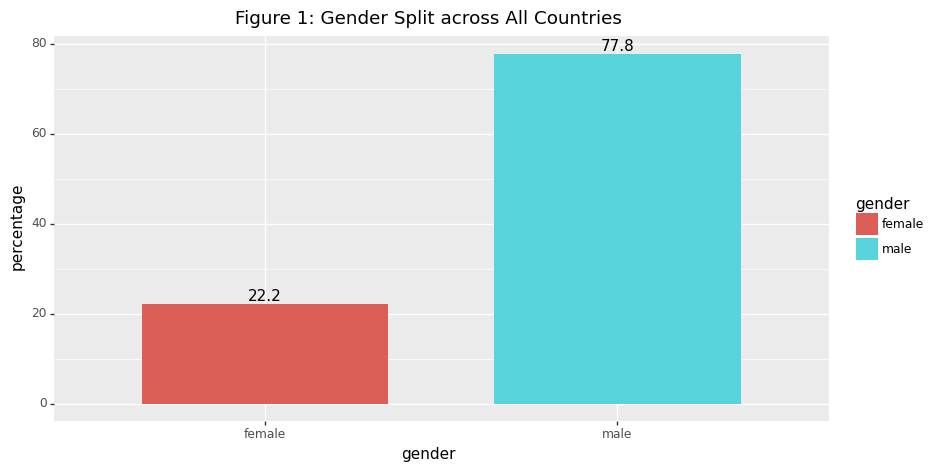Code
import pandas as pd
from plotnine import *
df=pd.read_csv('data/data.csv')Investigating disparities in gender amongst policians in different country groups is interesting. There are many underlying, systematic biases which result in a lack of female representation in certain industries and roles. We explore gender disparities in politics below.
The gender gap in political representation is relatively robust to different groupings based on HDI, MYS or other development indicators. The data clearly shows a heavily positive correlation between being a politician and being male. This is plausible - evidenced by historical and cultural norms, gender roles, structural barriers, and gender biases in the electorate.
gender_df=df.groupby(df['gender']).count()[['name']]
gender_df['percentage']=(gender_df['name']/gender_df['name'].sum()*100).round(1)
gender_df.rename(columns={'name':'count'},inplace=True)
gender_df.reset_index(inplace=True)
ggplot(gender_df, aes(x='gender', y='percentage', fill='gender'))\
+ geom_bar(stat='identity', position='dodge', width=0.7)\
+ geom_text(aes(label='percentage'), position=position_dodge(width=0.7), va='bottom')\
+ labs(title='Figure 1: Gender Split across All Countries')\
+ theme(figure_size=(10,5,))
We now group countries by certain characteristics, to try and identify whether some kinds of countries have more unequal splits than others.
As we would hypothesise, the disparity between becoming a politician given being male versus female is significantly more apparent for highly gender-unequal countries. This is shown most clearly by the percentage difference between being a politician given you are female for the highest Gender Inequality Index countries when compared to the lowest ones. So while the average split globally for gender representation is 22.2% female and 77.8% male, for the lowest GII countries it is 11.08% and 88.92%. However, gender split does not seem to be highly correlated to other development indicators such as income, MYS or HDI as shown in the graphs below. Due to the small variations in gender split observed between high/low non-gender focused indicators (MYS, HDI, V-DEM and income), we feel that this could be partially due to the lower data quality present in the EveryPolitician dataset for some of the less developed countries - perhaps further exploration by a future DS105 team would be interesting, focusing in on gender splits in less developed countries through another dataset.
import utils
# '''This module contains utility functions, variables, and data structures for use in the notebooks.'''
import pandas as pd
#------------------------------------Top and bottom countries of indices------------------------------------
# UN Indices Data:
indices_data=pd.read_csv('data/UN HDR all indices data.csv')
indices_data=indices_data[['country','hdi_2021','le_2021','eys_2021','mys_2021','gnipc_2021', 'gdi_2021','ihdi_2021','coef_ineq_2021','region', 'gii_2021']]
high_hdi=indices_data[indices_data['hdi_2021']>0.8]['country'].tolist()
low_hdi=indices_data[indices_data['hdi_2021']<0.7]['country'].tolist()
top_50_mys=indices_data.sort_values(by=['mys_2021'], ascending=False).head(50)['country'].tolist()
bottom_50_mys=indices_data.sort_values(by=['mys_2021'], ascending=True).head(50)['country'].tolist()
top_gii=indices_data.sort_values(by=['gii_2021'], ascending=False).head(20)['country'].tolist()
bottom_gii=indices_data.sort_values(by=['gii_2021'], ascending=True).head(20)['country'].tolist()
#------------------------------------Income groups------------------------------------
# World Bank Data:
wb_data=pd.read_csv('data/income_data.csv')
low_income=wb_data[wb_data['Income group']=='Low income']['Country'].tolist()
high_income=wb_data[wb_data['Income group']=='High income']['Country'].tolist()
#------------------------------------V-Dem Electoral Democracy Score------------------------------------
vdem_data=pd.read_csv('data/v_dem_elec_democracy.csv')
vdem_data=vdem_data.query('Year==2022')
low_dem=vdem_data[vdem_data['electdem_vdem_owid']<0.4]['Entity'].tolist()
high_dem=vdem_data[vdem_data['electdem_vdem_owid']>0.8]['Entity'].tolist()
#------------------------------------Hemispheres------------------------------------
#north_hem=['Algeria', 'Benin', 'Burkina Faso', 'Burundi', 'Cameroon', 'Central African Republic', 'Chad', 'Comoros', 'Djibouti', 'Egypt', 'Equatorial Guinea', 'Eritrea', 'Ethiopia', 'Gabon', 'Gambia', 'Ghana', 'Guinea', 'Guinea-Bissau', 'Ivory Coast', 'Kenya', 'Liberia', 'Libya', 'Mali', 'Mauritania', 'Niger', 'Nigeria', 'Rwanda', 'Senegal', 'Sierra Leone', 'Somalia', 'South Sudan', 'Sudan', 'Tanzania', 'Togo', 'Tunisia', 'Uganda', 'Zambia', 'Zimbabwe', 'Afghanistan', 'Armenia', 'Azerbaijan', 'Bahrain', 'Bangladesh', 'Bhutan', 'Brunei', 'Cambodia', 'China', 'Cyprus', 'Georgia', 'India', 'Indonesia', 'Iran', 'Iraq', 'Israel', 'Japan', 'Jordan', 'Kazakhstan', 'Kuwait', 'Kyrgyzstan', 'Laos', 'Lebanon', 'Malaysia', 'Maldives', 'Mongolia', 'Myanmar', 'Nepal', 'North Korea', 'Oman', 'Pakistan', 'Palestine', 'Philippines', 'Qatar', 'Russia', 'Saudi Arabia', 'Singapore', 'South Korea', 'Sri Lanka', 'Syria', 'Taiwan', 'Tajikistan', 'Thailand', 'Turkey', 'Turkmenistan', 'United Arab Emirates', 'Uzbekistan', 'Vietnam', 'Albania', 'Andorra', 'Austria', 'Belarus', 'Belgium', 'Bosnia and Herzegovina', 'Bulgaria', 'Croatia', 'Czech Republic', 'Denmark', 'Estonia', 'Finland', 'France', 'Germany', 'Greece', 'Hungary', 'Iceland', 'Ireland', 'Italy', 'Latvia', 'Liechtenstein', 'Lithuania', 'Luxembourg', 'Macedonia', 'Malta', 'Moldova', 'Monaco', 'Montenegro', 'Netherlands', 'North Macedonia', 'Norway', 'Poland', 'Portugal', 'Romania', 'San Marino', 'Serbia', 'Slovakia', 'Slovenia', 'Spain', 'Sweden', 'Switzerland', 'Vatican City', 'Antigua and Barbuda', 'Bahamas', 'Barbados', 'Belize', 'Canada', 'Costa Rica', 'Cuba', 'Dominica', 'Dominican Republic', 'El Salvador', 'Grenada', 'Guatemala', 'Haiti', 'Honduras', 'Jamaica', 'Mexico', 'Nicaragua', 'Panama', 'Saint Kitts and Nevis', 'Saint Lucia', 'Saint Vincent and the Grenadines', 'Trinidad and Tobago', 'United States of America', 'Oceania', 'Fiji', 'Kiribati', 'Marshall Islands', 'Micronesia', 'Nauru', 'New Zealand', 'Palau', 'Papua New Guinea', 'Samoa', 'Solomon Islands', 'Tonga', 'Tuvalu', 'Vanuatu']
countries=pd.read_csv('data/countries.csv',encoding='latin-1')
north_hem=countries[countries['latitude']>0]['name'].tolist()
south_hem=countries[countries['latitude']<0]['name'].tolist()
#------------------------------------Gender quotas------------------------------------
quotas_df=pd.read_csv('data/gender_quotas.csv')
legal_quotas=quotas_df[quotas_df['Voluntary political party quotas']=='No']['Country'].tolist()
# Gender inequality index (GII)
top_gii=df.query('country in @top_gii')
bottom_gii=df.query('country in @bottom_gii')
top_gii_df=top_gii.groupby('gender').count()[['name']]
bottom_gii_df=bottom_gii.groupby('gender').count()[['name']]
gender_df=pd.merge(top_gii_df, bottom_gii_df, how='inner',left_index=True,right_index=True)
gender_df.columns=['top_gii','bottom_gii']
# Add columns for percentage
gender_df['top_gii_pc']=(gender_df['top_gii']/gender_df['top_gii'].sum()*100).round(2)
gender_df['bottom_gii_pc']=(gender_df['bottom_gii']/gender_df['bottom_gii'].sum()*100).round(2)
# gender_df# Create a double bar plot for Gender Inequality Index analysis
gii_plot_df=pd.concat([gender_df[['top_gii_pc']].rename(columns={'top_gii_pc':'percentage'})\
,gender_df[['bottom_gii_pc']].rename(columns={'bottom_gii_pc':'percentage'})],axis=0).reset_index()
gii_plot_df['group']=['Highest GII Countries' if i<2 else 'Lowest GII Countries' for i in range(4)]
ggplot(gii_plot_df,aes(x='gender',y='percentage',fill='group'))\
+ geom_bar(stat='identity', position='dodge', width=0.7) \
+ labs(x='Gender', y='Percentage', title='Highest GII Countries vs Lowest GII Countries') \
+ theme(figure_size=(10, 5))
# HDI
high_hdi=df.query('country in @high_hdi')
low_hdi=df.query('country in @low_hdi')
high_hdi_df=high_hdi.groupby('gender').count()[['name']]
low_hdi_df=low_hdi.groupby('gender').count()[['name']]
gender_df=pd.merge(high_hdi_df, low_hdi_df, how='inner',left_index=True,right_index=True)
gender_df.columns=['high_hdi','low_hdi']
# Add columns for percentage
gender_df['high_hdi_pc']=(gender_df['high_hdi']/gender_df['high_hdi'].sum()*100).round(2)
gender_df['low_hdi_pc']=(gender_df['low_hdi']/gender_df['low_hdi'].sum()*100).round(2)
# gender_df # Create a double bar plot for HDI analysis
hdi_plot_df=pd.concat([gender_df[['high_hdi_pc']].rename(columns={'high_hdi_pc':'percentage'})\
,gender_df[['low_hdi_pc']].rename(columns={'low_hdi_pc':'percentage'})],axis=0).reset_index()
hdi_plot_df['group']=['High HDI Countries' if i<2 else 'Low HDI Countries' for i in range(4)]
# hdi_plot_df
ggplot(hdi_plot_df,aes(x='gender',y='percentage',fill='group'))\
+ geom_bar(stat='identity', position='dodge', width=0.7) \
+ labs(x='Gender', y='Percentage', title='High HDI Countries vs Low HDI Countries') \
+ theme(figure_size=(10, 5))
# V-Dem
high_vdem=df.query('country in @high_dem')
low_vdem=df.query('country in @low_dem')
high_vdem_df=high_vdem.groupby('gender').count()[['name']]
low_vdem_df=low_vdem.groupby('gender').count()[['name']]
gender_df=pd.merge(high_vdem_df, low_vdem_df, how='inner',left_index=True,right_index=True)
gender_df.columns=['high_vdem','low_vdem']
# Add columns for percentage
gender_df['high_vdem_pc']=(gender_df['high_vdem']/gender_df['high_vdem'].sum()*100).round(2)
gender_df['low_vdem_pc']=(gender_df['low_vdem']/gender_df['low_vdem'].sum()*100).round(2)
# gender_df
# Create a double bar plot for V-DEM analysis
vdem_plot_df=pd.concat([gender_df[['high_vdem_pc']].rename(columns={'high_vdem_pc':'percentage'})\
,gender_df[['low_vdem_pc']].rename(columns={'low_vdem_pc':'percentage'})],axis=0).reset_index()
vdem_plot_df['group']=['High V-DEM Countries' if i<2 else 'Low V-DEM Countries' for i in range(4)]
ggplot(vdem_plot_df,aes(x='gender',y='percentage',fill='group'))\
+ geom_bar(stat='identity', position='dodge', width=0.7) \
+ labs(x='Gender', y='Percentage', title='High V-DEM Countries vs Low V-DEM Countries') \
+ theme(figure_size=(10, 5))
# Income Category
high_income=df.query('country in @high_income')
low_income=df.query('country in @low_income')
high_income_df=high_income.groupby('gender').count()[['name']]
low_income_df=low_income.groupby('gender').count()[['name']]
gender_df=pd.merge(high_income_df, low_income_df, how='inner',left_index=True,right_index=True)
gender_df.columns=['high_income','low_income']
# Add columns for percentage
gender_df['high_income_pc']=(gender_df['high_income']/gender_df['high_income'].sum()*100).round(2)
gender_df['low_income_pc']=(gender_df['low_income']/gender_df['low_income'].sum()*100).round(2)
gender_df
# Create a double bar plot for Income analysis
income_plot_df=pd.concat([gender_df[['high_income_pc']].rename(columns={'high_income_pc':'percentage'})\
,gender_df[['low_income_pc']].rename(columns={'low_income_pc':'percentage'})],axis=0).reset_index()
income_plot_df['group']=['High Income Countries' if i<2 else 'Low Income Countries' for i in range(4)]
ggplot(income_plot_df,aes(x='gender',y='percentage',fill='group'))\
+ geom_bar(stat='identity', position='dodge', width=0.7) \
+ labs(x='Gender', y='Percentage', title='High Income Countries vs Low Income Countries') \
+ theme(figure_size=(10, 5))
# Gender Quotas
quotas=df.query('country in @legal_quotas')
no_quotas=df.query('country not in @legal_quotas')
quotas_df=quotas.groupby('gender').count()[['name']]
no_quotas_df=no_quotas.groupby('gender').count()[['name']]
gender_df=pd.merge(quotas_df, no_quotas_df, how='inner',left_index=True,right_index=True)
gender_df.columns=['quotas','no_quotas']
# Add columns for percentage
gender_df['quotas_pc']=(gender_df['quotas']/gender_df['quotas'].sum()*100).round(2)
gender_df['no_quotas_pc']=(gender_df['no_quotas']/gender_df['no_quotas'].sum()*100).round(2)
# gender_df
# Create a double bar plot for Quotas analysis
income_plot_df=pd.concat([gender_df[['quotas_pc']].rename(columns={'quotas_pc':'percentage'})\
,gender_df[['no_quotas_pc']].rename(columns={'no_quotas_pc':'percentage'})],axis=0).reset_index()
income_plot_df['group']=['Countries with Quotas' if i<2 else 'Countries without Quotas' for i in range(4)]
ggplot(income_plot_df,aes(x='gender',y='percentage',fill='group'))\
+ geom_bar(stat='identity', position='dodge', width=0.7) \
+ labs(x='Gender', y='Percentage', title='Countries with Quotas vs Countries without Quotas') \
+ theme(figure_size=(10, 5))